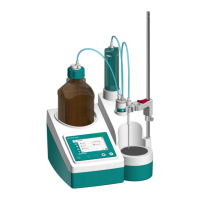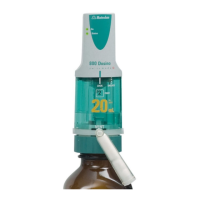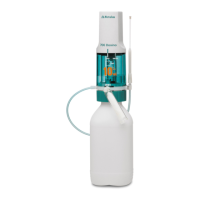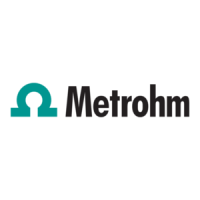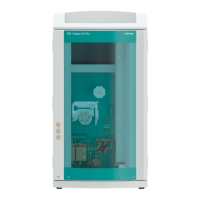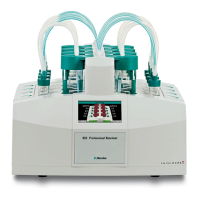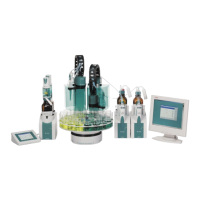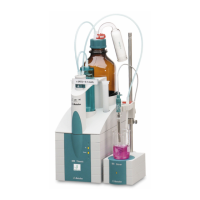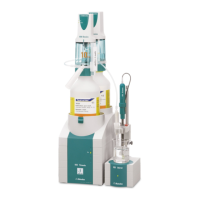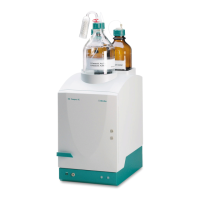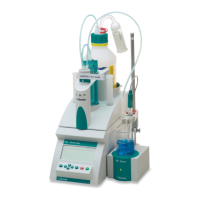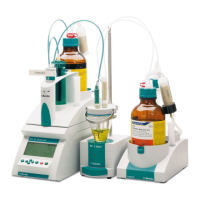Do you have a question about the Metrohm Dosimat plus 876 and is the answer not in the manual?
The 876 Dosimat plus is an all-purpose dosing device. Methods can be created and saved.
The 876 Dosimat plus is designed for precise liquid dosing in laboratories and production companies.
Information on how the manual is structured, including symbols and conventions used throughout the document.
General safety notes, electrical safety, tubing, flammable solvents, and disposal precautions for safe operation.
Describes the front view of the 876 Dosimat plus instrument, identifying key components like piston rod and keypad.
Details the Manual Dosing Controller, including its keys, status LED, and connection cable.
Covers packaging, checks, and selecting a suitable location for setting up the instrument.
Explains how to connect various Metrohm stirrers to the instrument.
Provides instructions for connecting the Manual Dosing Controller to the instrument's remote connector.
Details how to connect a balance using an RS-232/USB Box and appropriate cables.
Guide on connecting USB devices like keyboards, printers, and USB sticks using the adapter.
Instructions for integrating the instrument into an automation system using a remote cable.
Explains how to connect an 805 Dosimat for tandem operation via the MSB socket.
Step-by-step instructions for attaching the exchange unit to the 876 Dosimat plus.
Safety precautions and specifications for connecting the instrument to the power supply.
Procedures for powering the instrument on, including initialization, and switching it off.
Explains the instrument's keypad functions and the structure of its dialog windows.
Covers creating, saving, loading, and exporting methods for different dosing procedures.
Instructions for controlling a connected stirrer, including setting stirring rate and operation.
Details how to enter sample identification and size, including units, for calculations.
Procedure for rinsing and filling the buret unit to ensure it is air bubble-free.
Guide on how to print results, parameters, or system reports manually from the instrument.
Configuration of general instrument settings like user name, instrument name, time, date, and language.
How to manage solutions, including adding, editing, and deleting them for use with buret units.
Operations related to managing files on a USB flash drive, including import, delete, backup, and restore.
Settings for PC/LIMS reports, printer types, keyboard layouts, and balance configurations.
Procedures for loading new software or language files and understanding diagnosis functions.
Description of manual dosing mode, its use in titrations, and related parameters like dosing rate and volume.
Details of extended dosing modes including fixed volume, time-controlled, and rate-based dosing.
Information on the exchange unit, including maximum dosing and filling rates and preparation parameters.
How to adjust the stirring rate and the approximate rotational speed calculation for the internal stirrer.
Details on sending sample size and unit from a connected balance, including data format and handling.
Information on USB peripheral devices, including keypads and keyboards, and their connection requirements.
Procedure for initializing the instrument's file system, including data backup recommendations.
Pin assignment of the remote interface socket and plug, and status diagrams for remote control.
How to control the 876 Dosimat plus via pulse control using the remote interface.
Instructions for remote control of the instrument using an RS-232 connection and parameters.
Specifications for the dosing drive, including resolution, cylinder volumes, and accuracy standards.
Details on the available interfaces for connecting USB devices, stirrers, and remote instruments.
Technical specifications for power connection, including supply voltage, frequency, and power consumption.
Specifies the nominal function range, storage, and transport temperature conditions.
Defines the reference conditions for operation, including ambient temperature and relative humidity.
Physical dimensions of the instrument, including material of housing and display cover.
Instructions on how to download the list of delivery and optional accessories from the Metrohm website.
The 876 Dosimat plus is an all-purpose dosing device. Methods can be created and saved.
The 876 Dosimat plus is designed for precise liquid dosing in laboratories and production companies.
Information on how the manual is structured, including symbols and conventions used throughout the document.
General safety notes, electrical safety, tubing, flammable solvents, and disposal precautions for safe operation.
Describes the front view of the 876 Dosimat plus instrument, identifying key components like piston rod and keypad.
Details the Manual Dosing Controller, including its keys, status LED, and connection cable.
Covers packaging, checks, and selecting a suitable location for setting up the instrument.
Explains how to connect various Metrohm stirrers to the instrument.
Provides instructions for connecting the Manual Dosing Controller to the instrument's remote connector.
Details how to connect a balance using an RS-232/USB Box and appropriate cables.
Guide on connecting USB devices like keyboards, printers, and USB sticks using the adapter.
Instructions for integrating the instrument into an automation system using a remote cable.
Explains how to connect an 805 Dosimat for tandem operation via the MSB socket.
Step-by-step instructions for attaching the exchange unit to the 876 Dosimat plus.
Safety precautions and specifications for connecting the instrument to the power supply.
Procedures for powering the instrument on, including initialization, and switching it off.
Explains the instrument's keypad functions and the structure of its dialog windows.
Covers creating, saving, loading, and exporting methods for different dosing procedures.
Instructions for controlling a connected stirrer, including setting stirring rate and operation.
Details how to enter sample identification and size, including units, for calculations.
Procedure for rinsing and filling the buret unit to ensure it is air bubble-free.
Guide on how to print results, parameters, or system reports manually from the instrument.
Configuration of general instrument settings like user name, instrument name, time, date, and language.
How to manage solutions, including adding, editing, and deleting them for use with buret units.
Operations related to managing files on a USB flash drive, including import, delete, backup, and restore.
Settings for PC/LIMS reports, printer types, keyboard layouts, and balance configurations.
Procedures for loading new software or language files and understanding diagnosis functions.
Description of manual dosing mode, its use in titrations, and related parameters like dosing rate and volume.
Details of extended dosing modes including fixed volume, time-controlled, and rate-based dosing.
Information on the exchange unit, including maximum dosing and filling rates and preparation parameters.
How to adjust the stirring rate and the approximate rotational speed calculation for the internal stirrer.
Details on sending sample size and unit from a connected balance, including data format and handling.
Information on USB peripheral devices, including keypads and keyboards, and their connection requirements.
Procedure for initializing the instrument's file system, including data backup recommendations.
Pin assignment of the remote interface socket and plug, and status diagrams for remote control.
How to control the 876 Dosimat plus via pulse control using the remote interface.
Instructions for remote control of the instrument using an RS-232 connection and parameters.
Specifications for the dosing drive, including resolution, cylinder volumes, and accuracy standards.
Details on the available interfaces for connecting USB devices, stirrers, and remote instruments.
Technical specifications for power connection, including supply voltage, frequency, and power consumption.
Specifies the nominal function range, storage, and transport temperature conditions.
Defines the reference conditions for operation, including ambient temperature and relative humidity.
Physical dimensions of the instrument, including material of housing and display cover.
Instructions on how to download the list of delivery and optional accessories from the Metrohm website.
| Brand | Metrohm |
|---|---|
| Model | Dosimat plus 876 |
| Category | Laboratory Equipment |
| Language | English |
